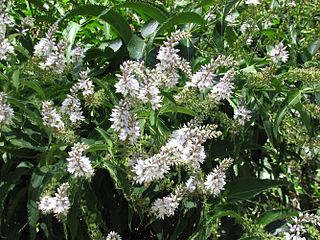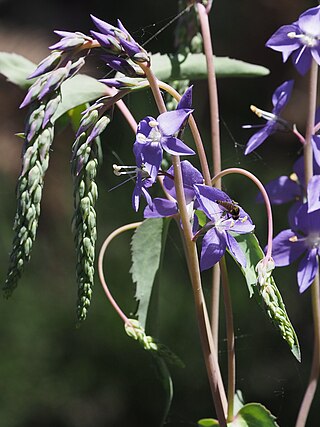
Mentha diemenica, commonly known as slender mint, is a flowering plant in the Lamiaceae family. It grows in the Northern Territory, Australian Capital Territory and all mainland states except Western Australia. It has mint-scented foliage and clusters of purple flowers.

Veronica derwentiana, commonly known as Derwent speedwell, is a flowering plant species of the family Plantaginaceae, endemic to south-eastern Australia. It is a perennial with toothed leaves and white or pale blue flowers in terminal sprays in spring and summer.
Melaleuca eulobata is a plant in the myrtle family, Myrtaceae and is endemic to the west coast of Western Australia. It is a shrub resembling Melaleuca campanae with its heads of pink flowers in late spring but is distinguished from that species by its sepals - in M. campane these are reduced to a ring of tissue but M. eulobata has distinct calyx lobes.

Veronica perfoliata, commonly known as digger's speedwell, is a common perennial herb found at higher altitudes in south-eastern Australia. It is a low-growing multi-stemmed plant rising from a woody rootstock. It has rounded blue-grey foliage and sprays of intense violet-blue flowers at the end of arching branches. It is occasionally cultivated as a garden plant.

Veronica arcuata is a flowering plant species in the family Plantaginaceae. It is native to northern New South Wales. The lilac coloured flowers are showy and conspicuous from late spring to late summer.

Veronica gracilis is a plant belonging to the family Plantaginaceae, commonly known as slender speedwell. It is a perennial herb with slender branches, variable shaped leaves and small lilac flowers in spring and summer.
Prostanthera athertoniana is a species of flowering plant in the family Lamiaceae and is endemic to a restricted area of Queensland. It is a small, densely-foliaged shrub with strongly aromatic, elliptical, oblong or egg-shaped leaves and hairy, purplish-mauve flowers arranged singly in upper leaf axils.

Prostanthera eungella is a species of flowering plant in the family Lamiaceae and is endemic to the Eungella region in Queensland. It is an erect shrub with narrow egg-shaped leaves with small teeth, and mauve flowers that are white inside the petal tube and arranged in upper leaf axils.

Goodenia byrnesii is a species of flowering plant in the family Goodeniaceae and is endemic to northern Australia. It is prostrate to low-lying herb with short-lived, lance-shaped leaves at the base, egg-shaped to oblong, toothed stem leaves, and leafy racemes of yellow flowers.
Goodenia effusa is a species of flowering plant in the family Goodeniaceae and is endemic to Queensland. It is an annual herb with many stems, needle-shaped, often curved leaves, and racemes of yellow flowers with brown veins.
Goodenia iyouta is a species of flowering plant in the family Goodeniaceae and is endemic to Western Australia. It is a prostrate herb with toothed, egg-shaped to elliptic stem-leaves, and racemes of dark yellow or cream-coloured flowers with a distinct pouch.
Goodenia leiosperma is a species of flowering plant in the family Goodeniaceae and is endemic to the Northern Territory. It is an ascending to low-lying herb with egg-shaped to lance-shaped stem-leaves and racemes of yellow flowers.

Goodenia arenicola is a species of flowering plant in the family Goodeniaceae and was endemic to Stradbroke Island in Queensland. It is a stolon-forming or rhizome-forming herb covered with soft hairs, with lance-shaped leaves mostly clustered at the end of short stems, and yellow flowers arranged singly in leaf axils. It is listed as extinct.
Goodenia redacta is a species of flowering plant in the family Goodeniaceae and is endemic to northern Australia. It is a prostrate to low-lying herb with toothed, egg-shaped leaves at the base of the plant, and racemes of yellow flowers with a brownish centre.
Goodenia suffrutescens is a species of flowering plant in the family Goodeniaceae and is endemic to inland areas of north-eastern Western Australia. It is an undershrub with low-lying branches, toothed, lance-shaped to egg-shaped leaves with the narrower end towards the base, and thyrses of blue flowers.
Gentiana wissmannii, commonly known as New England gentian, is a flowering plant in the family Gentianaceae and is endemic to New South Wales. It is a small, upright annual herb with blue flowers.
Lechenaultia ovata is a species of flowering plant in the family Goodeniaceae and is endemic to the Northern Territory. It is a perennial herb with rather fleshy, egg-shaped leaves, and white flowers.
Epacris navicularis is a species of flowering plant in the heath family Ericaceae and is endemic to south-western Tasmania. It is a shrub with crowded, overlapping egg-shaped leaves arranged in five rows, and bell-shaped white flowers crowded in upper leaf axils.
Sprengelia minima is a species of flowering plant of the family Ericaceae, and is endemic to Tasmania. It is a small shrub usually growing in alpine cushion plants and has many branches, overlapping, stem-clasping, sharply-pointed leaves, and white, tube-shaped flowers arranged singly on the ends of branches.

Sprengelia propinqua is a species of flowering plant of the family Ericaceae, and is endemic to Tasmania. It is an erect, robust shrub with overlapping, stem-clasping, egg-shaped leaves, and white flowers crowded in upper leaf axils.










